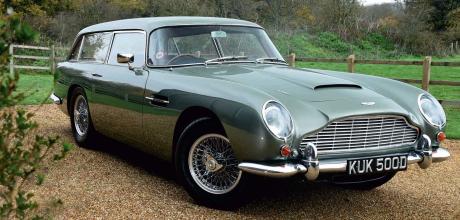1965 Aston Martin DB5 Radford Shooting Brake
Instigated by David Brown himself but hand-built by a London-based coachbuilder, Harold Radford, the DB5 Shooting Brake was aimed at Aston Martin owners who enjoyed outdoor pursuits and therefore needed more interior room. Just 12 were produced and we’ve tracked one down.
WORDS & PHOTOGRAPHY PAUL WALTON
BRAKE ROOM
British coachbuilder, Radford, produced just 12 Shooting Brakes based on the DB5. We’ve tracked down one of these rare estates
The Aston Martin DB5 can be described in many ways: beautiful, powerful, and desirable are just three adjectives that perfectly fit this now iconic model. Yet the one thing it can’t be called is practical. With its low roof line, lack of rear interior space and modest boot, even an original Mini would be a better choice for the supermarket run.
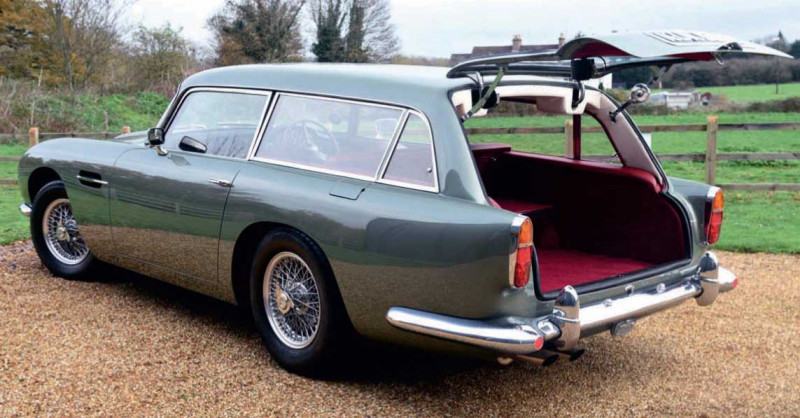
“Something of an outdoorsman, the car didn’t off er enough room for Brown’s polo gear or Labrador”
Ironically, this is the issue that faced Aston Martin’s then owner, (Sir) David Brown. Something of an outdoorsman, the car didn’t off er enough room for his polo gear or Labrador. Legend has it that in September 1965 he took the dog into an Aston Martin board meeting, put his four-legged friend on the long table and said, “Build me something he can sit in.”
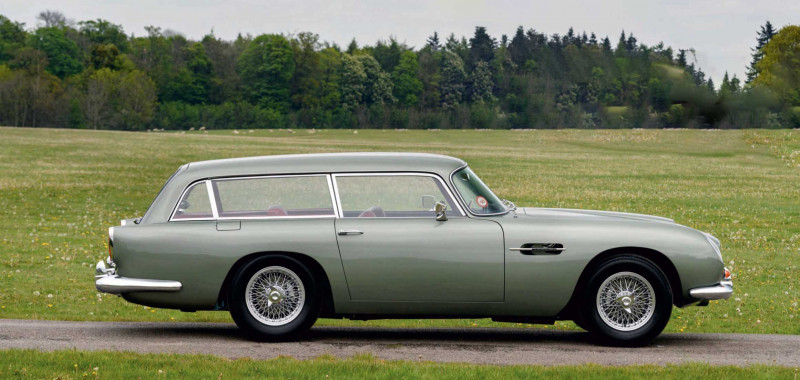
The result was the DB5 Shooting Brake, an elegant three-door estate that with its extended roof, and resultant large luggage space plus hatchback style of rear door, turned the car into a genuine multipurpose vehicle at a time when such models were relatively rare. With the estate market still very niche at the time and largely consisting of smaller cars such as the Mini Countryman and Morris Mini Traveller, it made the DB5 Shooting Brake ahead of its time.
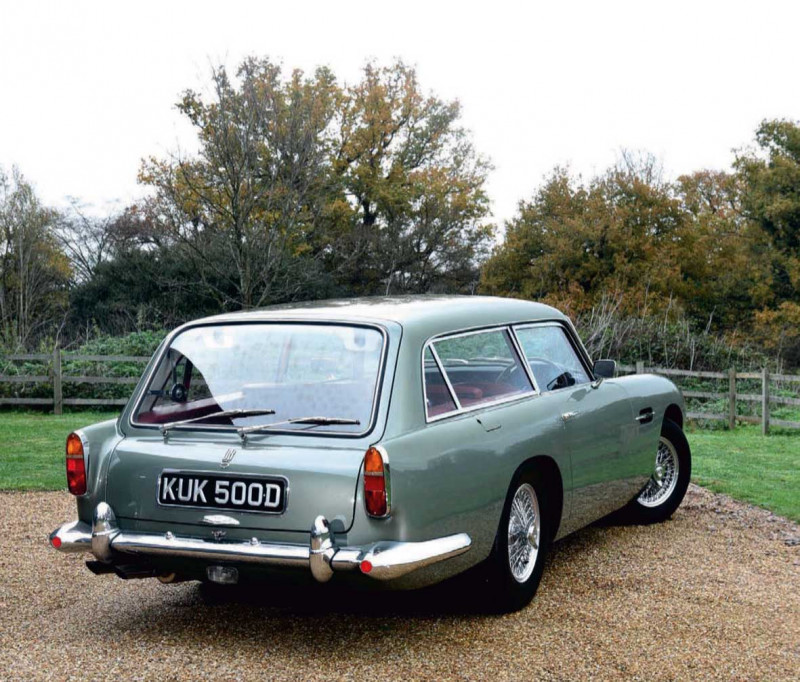
This wasn’t the first time Brown had considered such a car. In the early Sixties he asked Touring of Milan to design a five-door estate based on the Lagonda Rapide. But with the car being a slow seller – only 55 were produced in its three-year production run – the market for such a model would have been tiny so the project was scrapped. Assumed lost, Touring’s plans were discovered in the early 2000s and between 2005 and 2006 a specialist in the north east of England, the Carrosserie Company (UK) Ltd of Barnard Castle converted the seventh Rapide saloon off the production line into an estate.
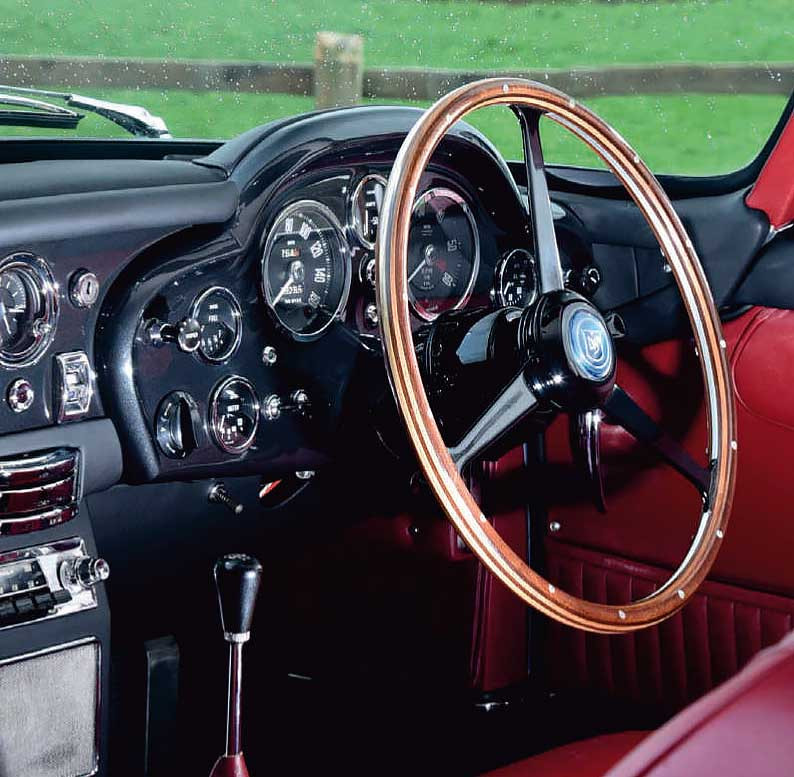
Before we go any further, let’s make the distinction between a shooting brake and a mere estate. Although there isn’t anything official, it’s universally accepted that an estate is a large, mass-produced, five-door hatchback, favoured by suburbanites for the school run and supermarket visits, slugging it on overcrowded roads with SUVs. Proper shooting brakes are usually a conversion of an existing model that’s built in tiny numbers and with three doors.
Although the project was instigated by David Brown, since the factory was too busy keeping up demand for the regular DB5, the eventual car was the work of independent British coachbuilder, Harold Radford.
Radford had started in the motor trade during the mid-Thirties when he borrowed a few hundred pounds from his father, a wealthy shipping broker, to start a car business, Harold Radford & Co Ltd, in South Kensington, London.
“I felt there was an opening for somebody who was going to have proper business training to start a motor business, and play the game 100 percent”, said the then 77-year-old Radford during a rare interview with journalist, Giles Chapman, in 1986. “No putting back speedometers and all that sort of outrageous nonsense. It was something I was determined to do.”
Thanks to his connections in the ‘old boy’ network, Radford was busy from the outset, soon opening an impressive glass-fronted showroom that was usually filled with nearly new Rolls-Royces and Bentleys, opposite the South Kensington underground station.
His move into coachbuilding was a result of customers asking him to modify cars to suit their needs. Largely mechanical-based to begin with, Harold was soon converting the big saloons into ‘shooting brakes’, large wood-framed estates that were popular for transporting guns and equipment during shooting parties held at country estates.
The work was subcontracted to Southgate-based coachbuilders, Seary & McReady. After the war (when he had joined the Mechanical Transport Corps), Radford bought a controlling interest in the company, relocated it to Ealing and changed the name to Harold Radford (Coachbuilders) Ltd. In 1948 he developed his Countryman conversion range for Rolls-Royce and Bentley that consisted of 40 luxurious and often clever designs. These included anything from a drinks cabinet, folding seats and an innovative split tailgate conversion to an entire coach-built body designed for field sports.
Following his father’s death in 1947, Harold became more involved with the family’s shipping company, taking over completely in the early Fifties. He eventually sold his coachbuilding business at the end of the decade to the Swain Group that owned several dealerships, which in turn became part of Provincial Traction Company Ltd in 1961. Harold Radford Ltd was later amalgamated with the service and body repair side of London’s leading Rolls- Royce and Bentley dealer, HR Owen, which Provincial also owned.
Radford was arguably best known during this time for several upmarket modifications it had developed for the humble Mini during the mid-Sixties under its De Ville name. It was another coachbuilder, Hooper, that had started the trend for an upmarket version of the diminutive car after producing one in 1963 for British film star, Peter Sellers. But when its rival wasn’t interested in taking the idea further, Radford was more than happy to do so. Favoured by the rich and famous, the Radford Mini de Ville remains synonymous with the Swinging Sixties.
Despite going bankrupt in 1967, the Radford name lingered on with a new company until 1975. It has been revived three times since then; the first came in 1992, two years after Harold himself had passed away, and consisted of modifications for the Mini. The second was a £30k transformation of BMW’s Mini in 2005. Neither came to much. More recently, the Radford name has been attached to a new company headed by the 2009 F1 champion, Jenson Button, TV presenter Ant Anstead and British car designer, Mark Stubbs. It plans to build a mid-engined sports car, the Type 62-2, that’s heavily based on the Lotus Exige.
After selling to Swain, Harold was originally kept on as managing director, but despite later being sidelined to ‘consultant’, he continued to hang around his former business. “He wanted to remain associated just to be able to say, ‘I am Harold Radford,’” said Eddie Collins, the company’s then manager, during a recent interview. “He was an absolutely charming man, though – someone who I would call a proper English gent.”
Still highly connected, it was Radford himself who secured the deal to convert the DB5 into a shooting brake. “David Brown, whom I knew very well indeed, came to me and asked if I would do an estate car on his Aston Martin, for shooting and that sort of thing,” continued Harold in Chapman’s 1986 interview.
The conversion was extensive and affected the whole car from the windscreen backwards. Radford’s engineers took tin snips to the Aston’s alloy roof and blended in a new panel that extended backwards to a onepiece rear door, hinged at the roof, and assisted by springs. One problem with the conversion was that the tubular structure of the roof also had to be cut away, reducing the rigidity of Touring’s clever Superleggera system.
Designed to create as much luggage space as possible, the shooting brake’s boot had a volume of 1,100 litres, making it slightly larger than that of the Ford Anglia Estate. But like the rest of the car’s mechanics, the DB5’s rear suspension was left alone, meaning it was for light loads only. But even after the conversion, Radford claimed the car was still capable of reaching 150mph while braking from 100mph to a complete stop took just six seconds. It was therefore marketed as, “The world’s fastest dual-purpose vehicle”. The first example was for Brown himself and debuted on Harold Radford’s stand at the 1965 Earls Court Motor Show in October. The shooting brake was then offered as a production model available to order through Aston Martin’s dealers, but it was still modified by Harold Radford. The conversion cost £2,000 – the same price as a Jaguar Mk X 4.2 – which, when added to the DB5’s £4,250 list price, resulted in a car that cost more than a Rolls-Royce Silver Cloud III. It’s probably for this reason why only a further 11 DB5 Shooting Brakes were produced and of those, just four were left-hand drive.
The example shown here is apparently the only one to have been based on a DB5 Vantage. Commissioned by Aston Martin main dealers, Cyril Williams Motors Ltd of Wolverhampton, the finished car was delivered to its first owner in 1966.
Design-wise, modifying an existing car into something else rarely works; the awkward-looking Jaguar XJ Series 3 estate by Avon-Stevens from the Eighties is a prime example of how bad it can be. But the DB5 Shooting Brake is clearly the exception to this rule. Its clean and svelte lines together with perfect detailing results in a car you’d think was designed and built at Aston Martin’s Newport Pagnell factory and not in a shed in London. It’s certainly better looking than Radford’s later DB6 version that was more hearse-like resulting in just six being produced.
When I lift the nicely sprung tailgate, I’m surprised by how much interior room there is considering the car it’s based on. Admittedly the large step in the floor that’s created when I tumble the rear seats forwards means the DB5 Shooting Brake wouldn’t be anyone’s choice for a trip to IKEA, but I still reckon there’s more than enough for both a saddle and a Labrador to sit comfortably.
Yet due to the high values the 12 examples are currently worth, it will have been a while since any have seen some muddy paw prints. In 2019, one of the four left-hand-drive cars was sold at auction in America for $1,765,000 (approximately 1,414,000).
There’s no denying that’s a huge sum, but the car’s practical boot yet still handsome lines together with the same high performance as the standard car results in a highly desirable package. So desirable in fact that Harold Radford’s DB5 Shooting Brake can be described by another word — perfect.


